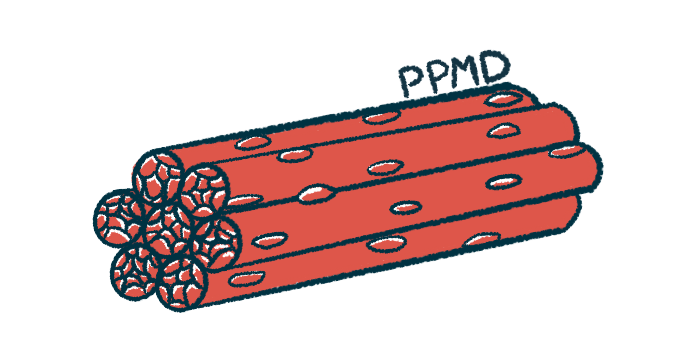PPMD 2024: DMD therapies to boost dystrophin advance in trials
Over half a dozen exon-skipping treatments now being tested, data show

More than half a dozen exon-skipping therapies for Duchenne muscular dystrophy (DMD) — all seeking to increase production of the dystrophin protein by modulating how the DMD gene is read — are now being explored in clinical trials, according to researchers.
Updates on several of these investigational DMD treatments were discussed during a session at last week’s Parent Project Muscular Dystrophy (PPMD) annual conference, held in Orlando, Florida, and virtually.
The dystrophin protein is important, these scientists note, as it normally acts like a shock absorber inside muscle cells, helping prevent wear and tear damage when muscles move about. Duchenne is caused by mutations in the DMD gene that encodes dystrophin. Lack of functional dystrophin leads muscles to accumulate damage over time, resulting in symptoms like muscle wasting and weakness.
Exon skipping is a strategy for DMD treatment that aims to boost levels of functional dystrophin protein in muscle cells. Exons are individual sections of genes that contain information on how to make proteins. When a gene is read, the exons are lined up and then processed one after another — a bit like how words are put together to make a sentence.
Many DMD-causing mutations cause the gene’s exons to become out of alignment. For example, imagine taking the first letter off each word in this sentence, and instead adding it to the end of the previous word. What results is a garbled string of gibberish, so the cell is not able to produce dystrophin protein. Exon skipping aims to mask certain exons so as to restore that alignment, ultimately allowing cells to produce a shortened but functional version of dystrophin protein.
DMD therapies are available in US, but have certain drawbacks
A few exon-skipping therapies are authorized in the U.S. for people with DMD caused by specific mutations. But while clinical trial data have shown these medicines can boost dystrophin production, the available therapies have notable drawbacks.
In particular, current exon-skipping treatments are not very bioavailable — in other words, when the therapy is administered, most of the drug does not actually get into a patient’s muscle cells.
Thus, these treatments need to be given at very high doses. This allows a small amount of the drug to get into muscles while the rest is flushed through the body.
We need to do better [in developing exon-skipping therapies].
The end result is that, with current exon-skipping therapies, “we get really expensive urine,” according to Annemieke Aartsma-Rus, PhD, a professor at Leiden University, in the Netherlands, and an expert on exon-skipping, who chaired the discussion at the PPMD conference.
“We need to do better,” Aartsma-Rus said, noting that several strategies are now being explored to improve the delivery of exon-skipping therapies to muscles.
Using antibodies and peptides to get DMD therapies into cells
One such strategy is to attach the exon-skipping molecule to an antibody that targets it to muscle cells. That’s the strategy used by Avidity Biosciences for AOC 1044, its experimental therapy designed to treat DMD amenable to exon 44 skipping, and by Dyne Therapeutics for DYNE-251, its experimental treatment to skip exon 51.
AOC 1044 is currently being tested in a Phase 1/2 trial called EXPLORE44 (NCT05670730). Data from the first part of the trial showed the therapy was well tolerated in healthy volunteers. Results from the second part of the trial, which is testing AOC 1044 in DMD patients, are expected later this year.
DYNE-251, meanwhile, is being tested in a Phase 1/2 study called DELIVER (NCT05524883). Early data showed that monthly treatment at a dose of 10 mg/kg led to increases in dystrophin production to just over 3% of normal levels, on average, after six months — which is higher dystrophin production than has been seen with older exon 51 skippers.
John Cox, Dyne’s CEO, said there also have been “some trends in functional benefit” in patients treated with Dyne-251, though he stressed it’s too early to make any conclusions about the therapy’s efficacy. Cox noted that DELIVER is testing a higher dose of 40 mg/kg.
Instead of an antibody, other investigational experimental exon skippers use a peptide (a small chain of amino acids, the building blocks of proteins) to increase delivery into muscle cells. One example is Entrada Therapeutics‘ ENTR-601-44, a candidate for exon 44 skipping that is currently being tested in healthy volunteers in a first-in-human trial. Early data showed no serious safety issues and evidence of exon skipping as expected.
Entrada is hoping to file later this year to start a Phase 2 trial of ENTR-601-44 in people with DMD. Later this year, the company also hopes to seek regulatory clearance to conduct a Phase 2 trial of an experimental therapy for exon 45 skipping, with similar plans for exon 50 skipping next year.
Other experimental exon-skipping treatments that uses a peptide include Pepgen‘s PGN-EDO51 and Sarepta Therapeutics‘ SRP-5051 (vesleteplirsen), both of which are designed to skip exon 51.
A Phase 2 trial called CONNECT1-EDO51 (NCT06079736) is ongoing in Canada to test PGN-EDO51 in eligible boys with DMD ages 8 and older. Authorities in the U.K. recently cleared the launch of a separate trial, dubbed CONNECT2-EDO51, which will test the therapy in patients ages 6 and older, and Pepgen is planning to expand that study also to sites in the U.S. and European Union. Both CONNECT studies are open to patients amenable to exon 51 skipping irrespective of walking ability; both will initially test several doses of therapy, then track outcomes with long-term treatment. Goals include assessing safety and dystrophin production.
Meanwhile, SRP-5051 is being evaluated in the ongoing Phase 2 study MOMENTUM (NCT04004065), which tested the therapy in both ambulatory and nonambulatory DMD patients. Results announced earlier this year indicated SRP-5051 boosted dystrophin production after six months on therapy, and Sarepta is planning to meet with the U.S. Food and Drug Administration (FDA) later this year to discuss next steps for the therapy.
Modifying the exon-skipping medicine itself
Other investigational exon-skipping therapies aren’t attached to an antibody or a peptide; instead, the exon-skipping molecule itself (a small piece of genetic material called an oligonucleotide) has been chemically altered so it’s better at getting into cells.
One example is Biomarin Pharmaceutical‘s BMN 351. Biomarin is running a Phase 1/2 trial (NCT06280209) to explore the safety and pharmacological properties of BMN 351 in DMD patients ages 4 through 10 who have eligible mutations and are able to walk. The trial is recruiting participants at sites in Italy, the U.K., Spain, and Turkey.
Another unattached exon-skipping therapy is WVE-N531, which targets exon 53 and is being developed by Wave Life Sciences. WVE-N531 is being tested in the Phase 1b/2a trial FORWARD-53 (NCT04906460), which aims to evaluate the therapy’s effect on dystrophin production. Early data from the first three patients indicated acceptable safety and evidence of exon skipping; full results from all 11 participants are expected later this year.
NS Pharma also is developing unattached exon-skipping therapies. Its experimental treatment targeting exon 44, called brogidirsen (formerly NS-089), is being tested in a Phase 2 study dubbed DISCOVER (NCT05996003). Recruitment is ongoing at sites in the U.S., with an estimated enrollment of 20.
DISCOVER aims to enroll boys with DMD, ages 4-14, who are able to walk and are on stable doses of corticosteroids. The first part of the trial will evaluate the safety of several doses of brogidirsen, given weekly. Then, in the second part of the study, the maximum tolerated dose will be tested for about six months, with the main goal of evaluating the therapy’s effects on dystrophin protein production.
NS also recently launched a Phase 2 study called Meteor50 (NCT06053814), which follows a similar design to DISCOVER but will test another of the company’s experimental exon-skipping therapies — this one called NS-050/NCNP-03 — which is designed to skip exon 50. That study is not yet recruiting participants.
Note: The Muscular Dystrophy News Today team is providing virtual coverage of the Parent Project Muscular Dystrophy Annual Conference (PPMD) June 27-29. Go here to see the latest stories from the conference.









